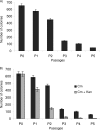Stability of a Spodoptera frugiperda nucleopolyhedrovirus deletion recombinant during serial passage in insects
- PMID: 20008167
- PMCID: PMC2813023
- DOI: 10.1128/AEM.01894-09
Stability of a Spodoptera frugiperda nucleopolyhedrovirus deletion recombinant during serial passage in insects
Abstract
The stabilities of the Spodoptera frugiperda multiple nucleopolyhedrovirus (SfMNPV) complete genome bacmid (Sfbac) and a deletion recombinant (Sf29null) in which the Sf29 gene was replaced by a kanamycin resistance cassette were determined during sequential rounds of per os infection in insect larvae. The Sf29 gene is a viral factor that determines the number of virions in occlusion bodies (OBs). The Sf29null bacmid virus was able to recover the Sf29 gene during passage. After the third passage (P3) of Sf29null bacmid OBs, the population was observed to reach an equilibrium involving a mixture of those with a kanamycin resistance cassette and those with the Sf29 gene. The biological activity of Sf29null bacmid OBs at P3 was similar to that of Sfbac OBs. The recovered gene in the Sf29null virus was 98 to 100% homologous to the Sf29 genes of different SfMNPV genotypes. Reverse transcription-PCR analysis of uninoculated S. frugiperda larvae confirmed the expression of the SfMNPV ie-0 and Sf29 genes, indicating that the insect colony harbors a covert SfMNPV infection. Additionally, the nonessential bacterial artificial chromosome vector was spontaneously deleted from both viral genomes upon passage in insects.
Figures




Similar articles
-
Sf29 gene of Spodoptera frugiperda multiple nucleopolyhedrovirus is a viral factor that determines the number of virions in occlusion bodies.J Virol. 2008 Aug;82(16):7897-904. doi: 10.1128/JVI.00099-08. Epub 2008 Jun 11. J Virol. 2008. PMID: 18550678 Free PMC article.
-
Analysis of a naturally-occurring deletion mutant of Spodoptera frugiperda multiple nucleopolyhedrovirus reveals sf58 as a new per os infectivity factor of lepidopteran-infecting baculoviruses.J Invertebr Pathol. 2012 Jan;109(1):117-26. doi: 10.1016/j.jip.2011.10.010. Epub 2011 Oct 21. J Invertebr Pathol. 2012. PMID: 22041202
-
The sf32 unique gene of Spodoptera frugiperda multiple nucleopolyhedrovirus (SfMNPV) is a non-essential gene that could be involved in nucleocapsid organization in occlusion-derived virions.PLoS One. 2013 Oct 30;8(10):e77683. doi: 10.1371/journal.pone.0077683. eCollection 2013. PLoS One. 2013. PMID: 24204916 Free PMC article.
-
Genomic sequence analysis of a fast-killing isolate of Spodoptera frugiperda multiple nucleopolyhedrovirus.J Gen Virol. 2008 Mar;89(Pt 3):775-790. doi: 10.1099/vir.0.83566-0. J Gen Virol. 2008. PMID: 18272770
-
Evidence of recent interspecies horizontal gene transfer regarding nucleopolyhedrovirus infection of Spodoptera frugiperda.BMC Genomics. 2015 Nov 25;16:1008. doi: 10.1186/s12864-015-2218-5. BMC Genomics. 2015. PMID: 26607569 Free PMC article.
Cited by
-
Baculovirus Expression and Functional Analysis of Vpa2 Proteins from Bacillus thuringiensis.Toxins (Basel). 2020 Aug 22;12(9):543. doi: 10.3390/toxins12090543. Toxins (Basel). 2020. PMID: 32842608 Free PMC article.
-
Using Next Generation Sequencing to Identify and Quantify the Genetic Composition of Resistance-Breaking Commercial Isolates of Cydia pomonella Granulovirus.Viruses. 2017 Sep 4;9(9):250. doi: 10.3390/v9090250. Viruses. 2017. PMID: 28869567 Free PMC article.
-
Baculovirus Genetic Diversity and Population Structure.Viruses. 2025 Jan 22;17(2):142. doi: 10.3390/v17020142. Viruses. 2025. PMID: 40006898 Free PMC article. Review.
References
-
- Burden, J. P., C. P. Nixon, A. E. Hodgkinson, R. D. Possee, S. M. Sait, L. A. King, and R. S. Hails. 2003. Covert infections as a mechanism for long-term persistence of baculoviruses. Ecol. Lett. 6:524-531.
-
- Cooper, D., J. S. Cory, D. A. Theilmann, and J. H. Myers. 2003. Nucleopolyhedroviruses of forest and western tent caterpillars: cross-infectivity and evidence for activation of latent virus in high-density field populations. Ecol. Entomol. 28:41-50.
Publication types
MeSH terms
Substances
LinkOut - more resources
Full Text Sources

